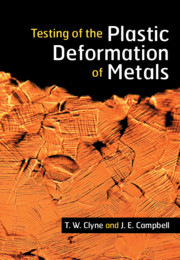Book contents
- Testing of the Plastic Deformation of Metals
- Reviews
- Testing of the Plastic Deformation of Metals
- Copyright page
- Contents
- Preface
- Nomenclature
- 1 General Introduction
- 2 Stresses, Strains and Elasticity
- 3 Continuum Plasticity
- 4 Mechanisms of Plastic Deformation in Metals
- 5 Tensile Testing
- 6 Compressive Testing
- 7 Hardness Testing
- 8 Indentation Plastometry
- 9 Nanoindentation and Micropillar Compression
- 10 Other Testing Geometries and Conditions
- Index
- References
8 - Indentation Plastometry
Published online by Cambridge University Press: 24 May 2021
- Testing of the Plastic Deformation of Metals
- Reviews
- Testing of the Plastic Deformation of Metals
- Copyright page
- Contents
- Preface
- Nomenclature
- 1 General Introduction
- 2 Stresses, Strains and Elasticity
- 3 Continuum Plasticity
- 4 Mechanisms of Plastic Deformation in Metals
- 5 Tensile Testing
- 6 Compressive Testing
- 7 Hardness Testing
- 8 Indentation Plastometry
- 9 Nanoindentation and Micropillar Compression
- 10 Other Testing Geometries and Conditions
- Index
- References
Summary
Indentation plastometry is now emerging as a potentially valuable addition to the range of testing techniques in widespread use. In many ways, it incorporates an amalgamation of the convenience and ease of usage offered by hardness testing with the more rigorous and meaningful outcomes expected of tensile testing. The indentation procedure itself is very similar to that of hardness testing, except that the loads required are higher than those used in most types of hardness test. The major difference is that the experimental data extracted are much more comprehensive, either in the form of a load–displacement plot or as a residual indent profile (with the latter offering several advantages). However, these experimental data only become useful if they can be processed so as to obtain a (true) stress–strain relationship, which can in turn be used to predict the (nominal) stress–strain curve of a conventional tensile test, including the strength (UTS) and the post-necking and rupture characteristics. This can only be done in a reliable way via iterative FEM simulation of the indentation process, but commercial packages in which this capability is integrated with a test facility are now becoming available.
Information
- Type
- Chapter
- Information
- Testing of the Plastic Deformation of Metals , pp. 148 - 191Publisher: Cambridge University PressPrint publication year: 2021
References
Accessibility standard: Unknown
Why this information is here
This section outlines the accessibility features of this content - including support for screen readers, full keyboard navigation and high-contrast display options. This may not be relevant for you.Accessibility Information
- 1
- Cited by
